Health Evaluation and Planning: Hospital Complications Analysis
VerifiedAdded on 2021/05/31
|20
|4088
|50
Report
AI Summary
This report provides a comprehensive analysis of hospital-acquired complications, focusing on the experiences of elderly patients across three hospitals: Liverpool, Gosford, and St. George. The study examines self-reported data, comparing findings with NSW reports to identify key issues such as pressure injuries, falls, medication errors, infections, and post-surgical complications. The report delves into the statistical data from 2015 and 2016 for each hospital, highlighting trends and areas of concern. The analysis considers demographic changes and the increased vulnerability of elderly patients to adverse events during hospital stays. Evidence-based strategies are proposed to manage patient complication rates, including solutions for fall control, medication error reduction, injury prevention, pressure injury management, and the control of hospital-acquired infections. The report underscores the importance of improved healthcare delivery and the need for proactive measures to enhance the quality of life for elderly patients in hospital settings.
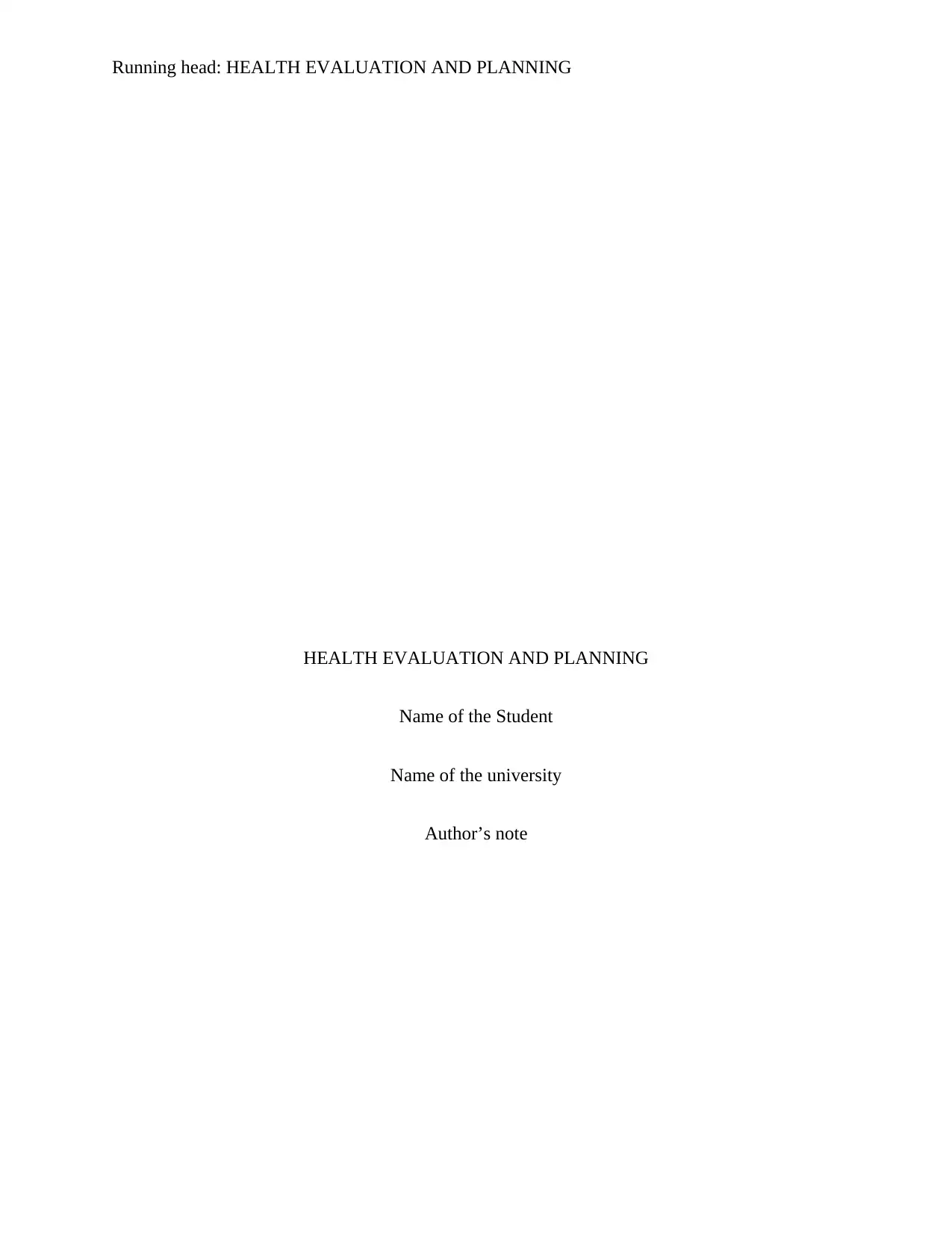
Running head: HEALTH EVALUATION AND PLANNING
HEALTH EVALUATION AND PLANNING
Name of the Student
Name of the university
Author’s note
HEALTH EVALUATION AND PLANNING
Name of the Student
Name of the university
Author’s note
Paraphrase This Document
Need a fresh take? Get an instant paraphrase of this document with our AI Paraphraser
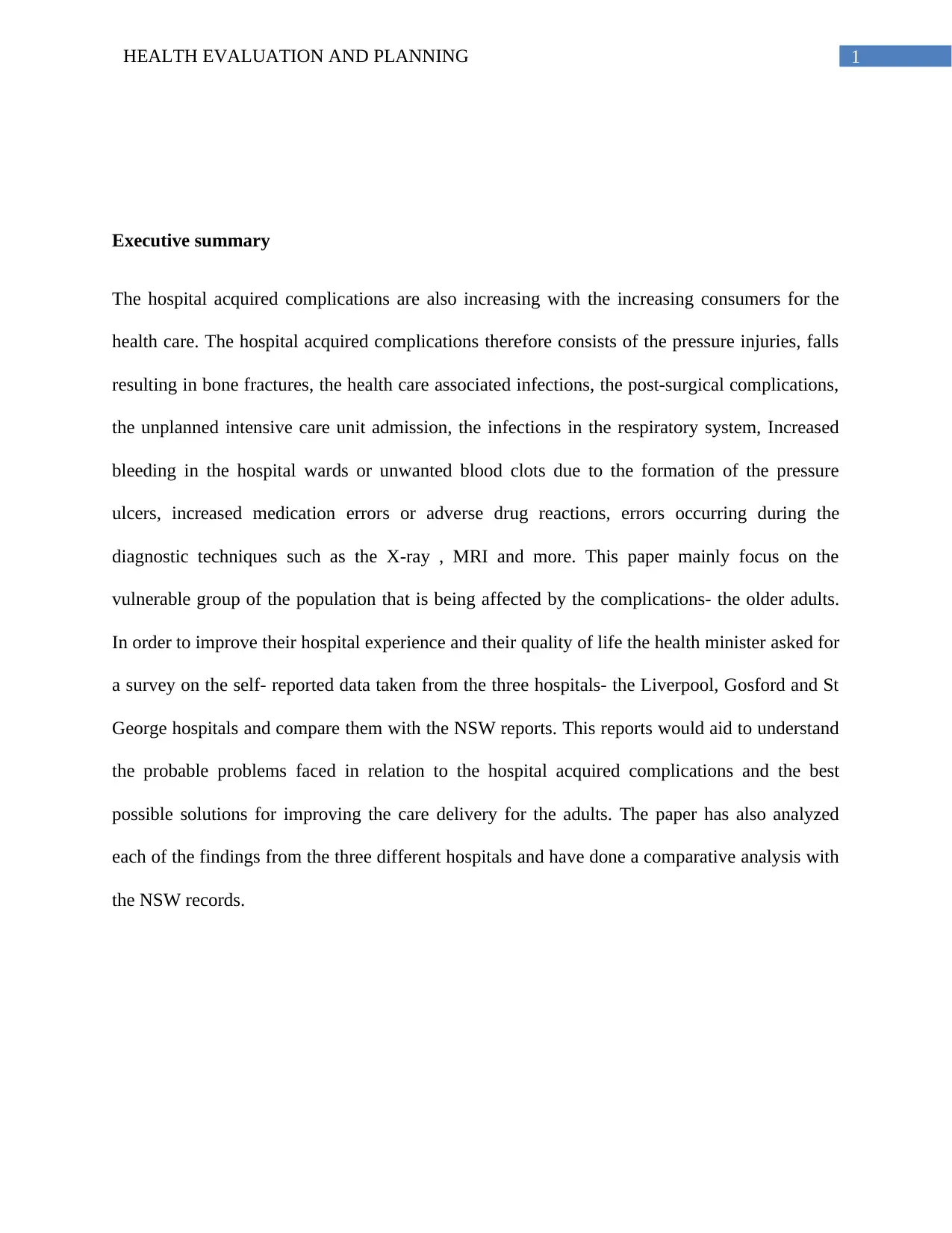
1HEALTH EVALUATION AND PLANNING
Executive summary
The hospital acquired complications are also increasing with the increasing consumers for the
health care. The hospital acquired complications therefore consists of the pressure injuries, falls
resulting in bone fractures, the health care associated infections, the post-surgical complications,
the unplanned intensive care unit admission, the infections in the respiratory system, Increased
bleeding in the hospital wards or unwanted blood clots due to the formation of the pressure
ulcers, increased medication errors or adverse drug reactions, errors occurring during the
diagnostic techniques such as the X-ray , MRI and more. This paper mainly focus on the
vulnerable group of the population that is being affected by the complications- the older adults.
In order to improve their hospital experience and their quality of life the health minister asked for
a survey on the self- reported data taken from the three hospitals- the Liverpool, Gosford and St
George hospitals and compare them with the NSW reports. This reports would aid to understand
the probable problems faced in relation to the hospital acquired complications and the best
possible solutions for improving the care delivery for the adults. The paper has also analyzed
each of the findings from the three different hospitals and have done a comparative analysis with
the NSW records.
Executive summary
The hospital acquired complications are also increasing with the increasing consumers for the
health care. The hospital acquired complications therefore consists of the pressure injuries, falls
resulting in bone fractures, the health care associated infections, the post-surgical complications,
the unplanned intensive care unit admission, the infections in the respiratory system, Increased
bleeding in the hospital wards or unwanted blood clots due to the formation of the pressure
ulcers, increased medication errors or adverse drug reactions, errors occurring during the
diagnostic techniques such as the X-ray , MRI and more. This paper mainly focus on the
vulnerable group of the population that is being affected by the complications- the older adults.
In order to improve their hospital experience and their quality of life the health minister asked for
a survey on the self- reported data taken from the three hospitals- the Liverpool, Gosford and St
George hospitals and compare them with the NSW reports. This reports would aid to understand
the probable problems faced in relation to the hospital acquired complications and the best
possible solutions for improving the care delivery for the adults. The paper has also analyzed
each of the findings from the three different hospitals and have done a comparative analysis with
the NSW records.
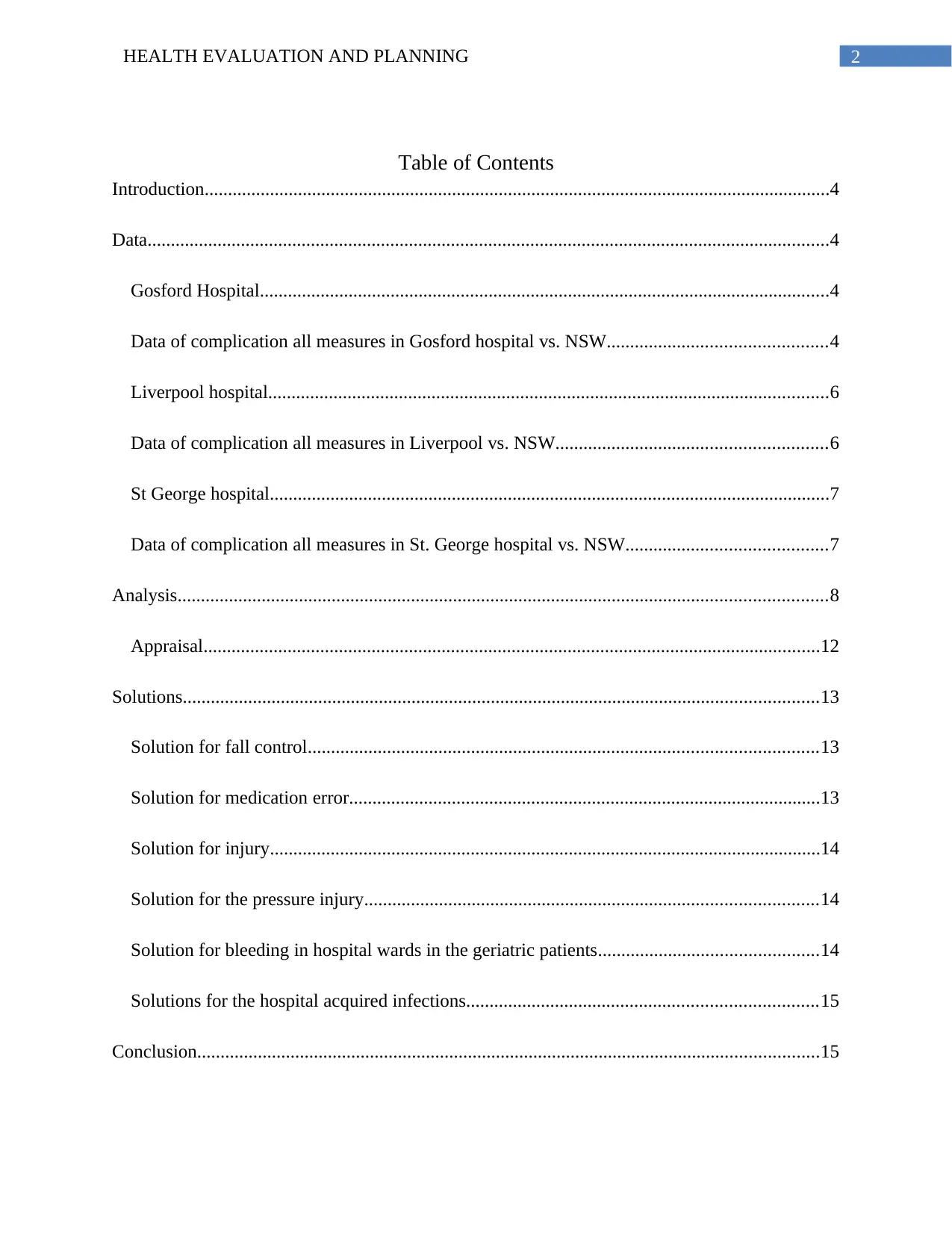
2HEALTH EVALUATION AND PLANNING
Table of Contents
Introduction......................................................................................................................................4
Data..................................................................................................................................................4
Gosford Hospital..........................................................................................................................4
Data of complication all measures in Gosford hospital vs. NSW...............................................4
Liverpool hospital........................................................................................................................6
Data of complication all measures in Liverpool vs. NSW..........................................................6
St George hospital........................................................................................................................7
Data of complication all measures in St. George hospital vs. NSW...........................................7
Analysis...........................................................................................................................................8
Appraisal....................................................................................................................................12
Solutions........................................................................................................................................13
Solution for fall control.............................................................................................................13
Solution for medication error.....................................................................................................13
Solution for injury......................................................................................................................14
Solution for the pressure injury.................................................................................................14
Solution for bleeding in hospital wards in the geriatric patients...............................................14
Solutions for the hospital acquired infections...........................................................................15
Conclusion.....................................................................................................................................15
Table of Contents
Introduction......................................................................................................................................4
Data..................................................................................................................................................4
Gosford Hospital..........................................................................................................................4
Data of complication all measures in Gosford hospital vs. NSW...............................................4
Liverpool hospital........................................................................................................................6
Data of complication all measures in Liverpool vs. NSW..........................................................6
St George hospital........................................................................................................................7
Data of complication all measures in St. George hospital vs. NSW...........................................7
Analysis...........................................................................................................................................8
Appraisal....................................................................................................................................12
Solutions........................................................................................................................................13
Solution for fall control.............................................................................................................13
Solution for medication error.....................................................................................................13
Solution for injury......................................................................................................................14
Solution for the pressure injury.................................................................................................14
Solution for bleeding in hospital wards in the geriatric patients...............................................14
Solutions for the hospital acquired infections...........................................................................15
Conclusion.....................................................................................................................................15
⊘ This is a preview!⊘
Do you want full access?
Subscribe today to unlock all pages.

Trusted by 1+ million students worldwide
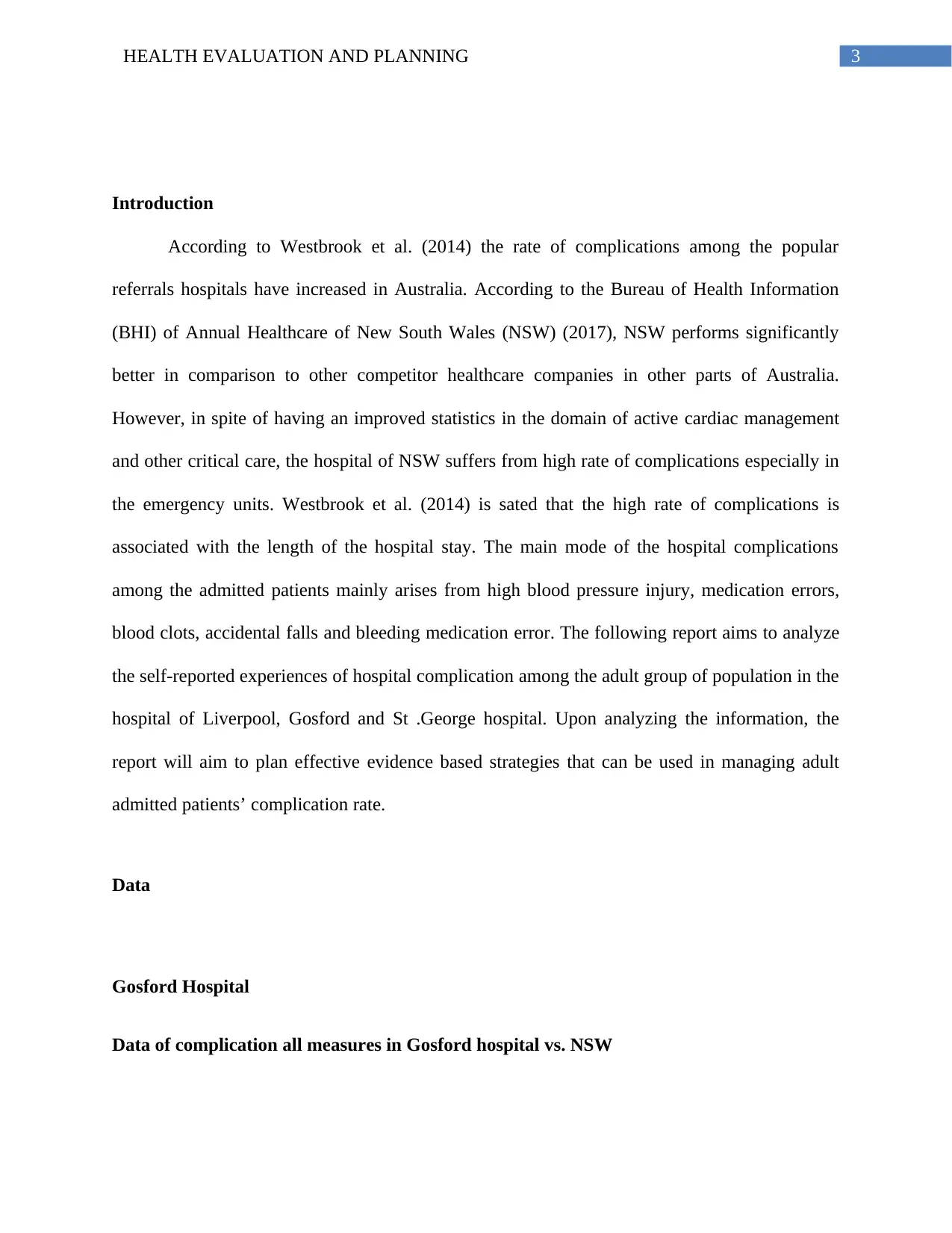
3HEALTH EVALUATION AND PLANNING
Introduction
According to Westbrook et al. (2014) the rate of complications among the popular
referrals hospitals have increased in Australia. According to the Bureau of Health Information
(BHI) of Annual Healthcare of New South Wales (NSW) (2017), NSW performs significantly
better in comparison to other competitor healthcare companies in other parts of Australia.
However, in spite of having an improved statistics in the domain of active cardiac management
and other critical care, the hospital of NSW suffers from high rate of complications especially in
the emergency units. Westbrook et al. (2014) is sated that the high rate of complications is
associated with the length of the hospital stay. The main mode of the hospital complications
among the admitted patients mainly arises from high blood pressure injury, medication errors,
blood clots, accidental falls and bleeding medication error. The following report aims to analyze
the self-reported experiences of hospital complication among the adult group of population in the
hospital of Liverpool, Gosford and St .George hospital. Upon analyzing the information, the
report will aim to plan effective evidence based strategies that can be used in managing adult
admitted patients’ complication rate.
Data
Gosford Hospital
Data of complication all measures in Gosford hospital vs. NSW
Introduction
According to Westbrook et al. (2014) the rate of complications among the popular
referrals hospitals have increased in Australia. According to the Bureau of Health Information
(BHI) of Annual Healthcare of New South Wales (NSW) (2017), NSW performs significantly
better in comparison to other competitor healthcare companies in other parts of Australia.
However, in spite of having an improved statistics in the domain of active cardiac management
and other critical care, the hospital of NSW suffers from high rate of complications especially in
the emergency units. Westbrook et al. (2014) is sated that the high rate of complications is
associated with the length of the hospital stay. The main mode of the hospital complications
among the admitted patients mainly arises from high blood pressure injury, medication errors,
blood clots, accidental falls and bleeding medication error. The following report aims to analyze
the self-reported experiences of hospital complication among the adult group of population in the
hospital of Liverpool, Gosford and St .George hospital. Upon analyzing the information, the
report will aim to plan effective evidence based strategies that can be used in managing adult
admitted patients’ complication rate.
Data
Gosford Hospital
Data of complication all measures in Gosford hospital vs. NSW
Paraphrase This Document
Need a fresh take? Get an instant paraphrase of this document with our AI Paraphraser
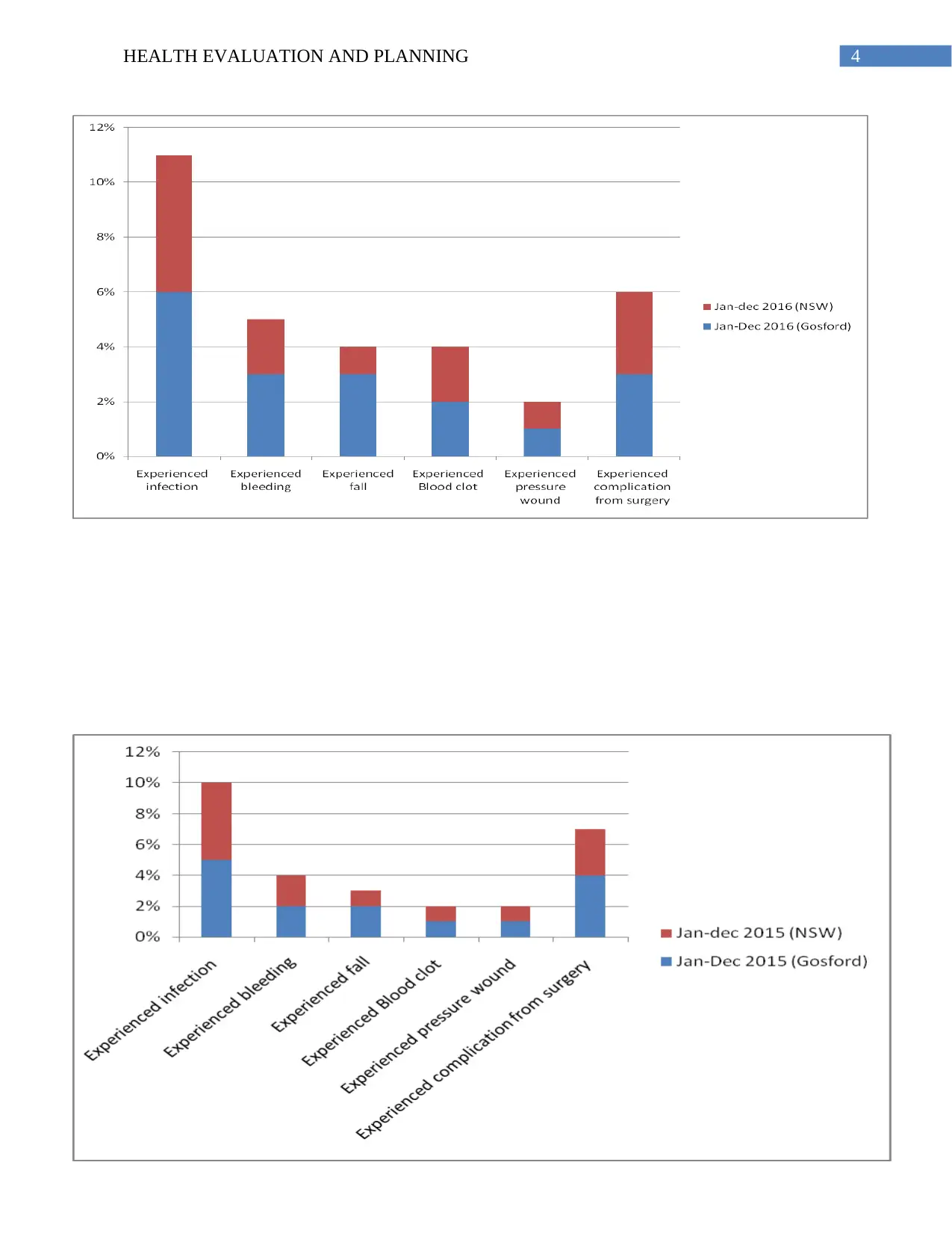
4HEALTH EVALUATION AND PLANNING
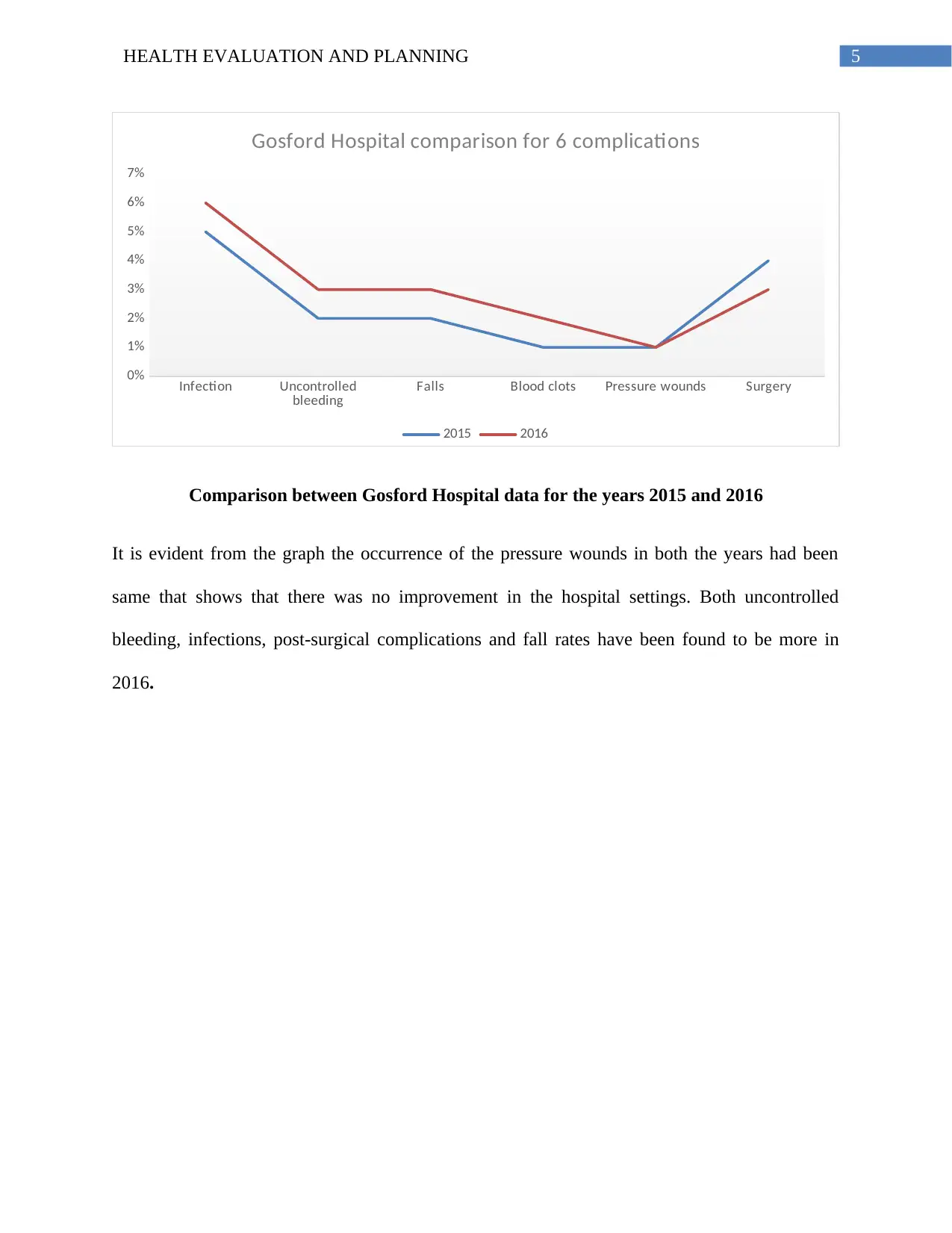
5HEALTH EVALUATION AND PLANNING
Infection Uncontrolled
bleeding Falls Blood clots Pressure wounds Surgery
0%
1%
2%
3%
4%
5%
6%
7%
Gosford Hospital comparison for 6 complications
2015 2016
Comparison between Gosford Hospital data for the years 2015 and 2016
It is evident from the graph the occurrence of the pressure wounds in both the years had been
same that shows that there was no improvement in the hospital settings. Both uncontrolled
bleeding, infections, post-surgical complications and fall rates have been found to be more in
2016.
Infection Uncontrolled
bleeding Falls Blood clots Pressure wounds Surgery
0%
1%
2%
3%
4%
5%
6%
7%
Gosford Hospital comparison for 6 complications
2015 2016
Comparison between Gosford Hospital data for the years 2015 and 2016
It is evident from the graph the occurrence of the pressure wounds in both the years had been
same that shows that there was no improvement in the hospital settings. Both uncontrolled
bleeding, infections, post-surgical complications and fall rates have been found to be more in
2016.
⊘ This is a preview!⊘
Do you want full access?
Subscribe today to unlock all pages.

Trusted by 1+ million students worldwide
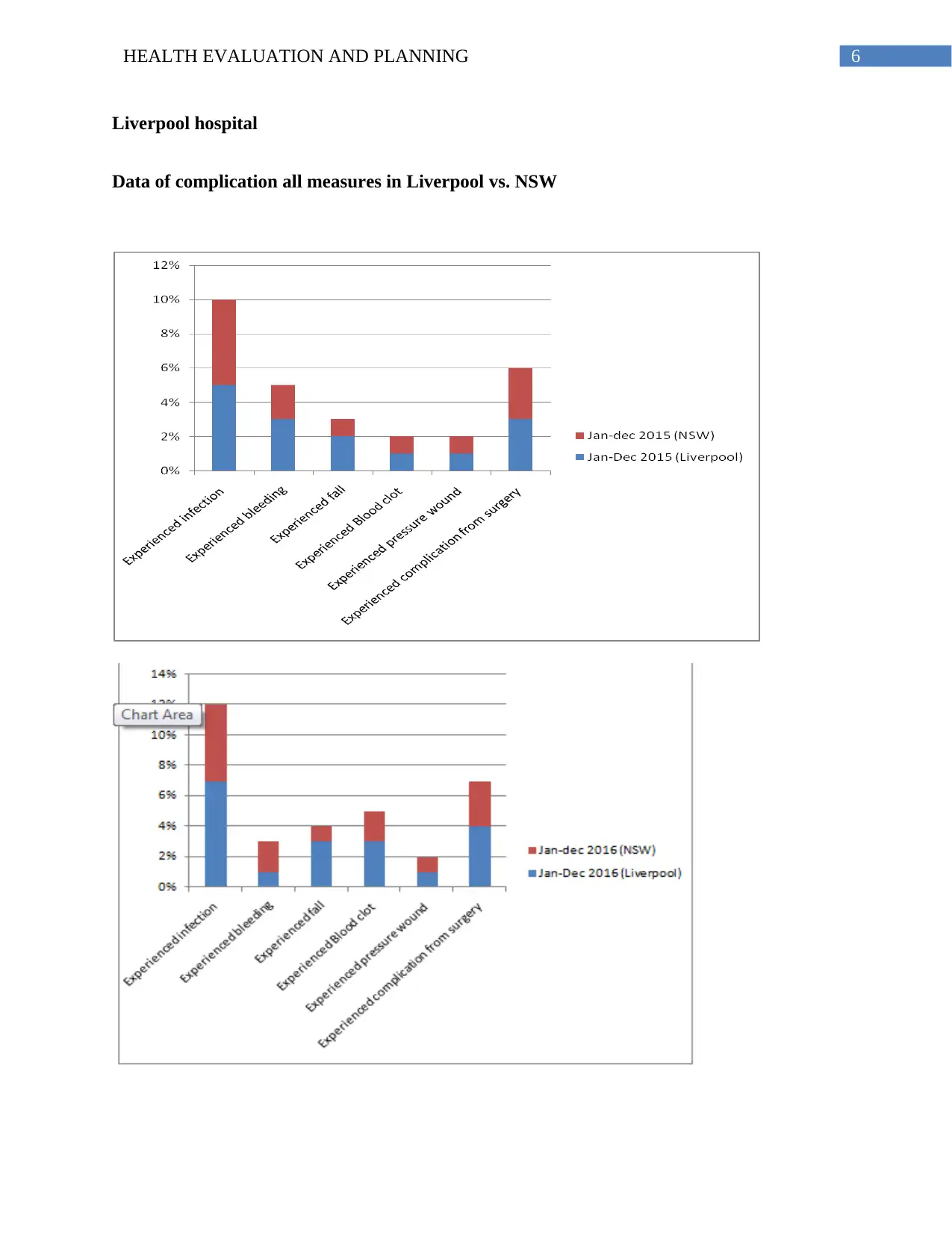
6HEALTH EVALUATION AND PLANNING
Liverpool hospital
Data of complication all measures in Liverpool vs. NSW
Liverpool hospital
Data of complication all measures in Liverpool vs. NSW
Paraphrase This Document
Need a fresh take? Get an instant paraphrase of this document with our AI Paraphraser
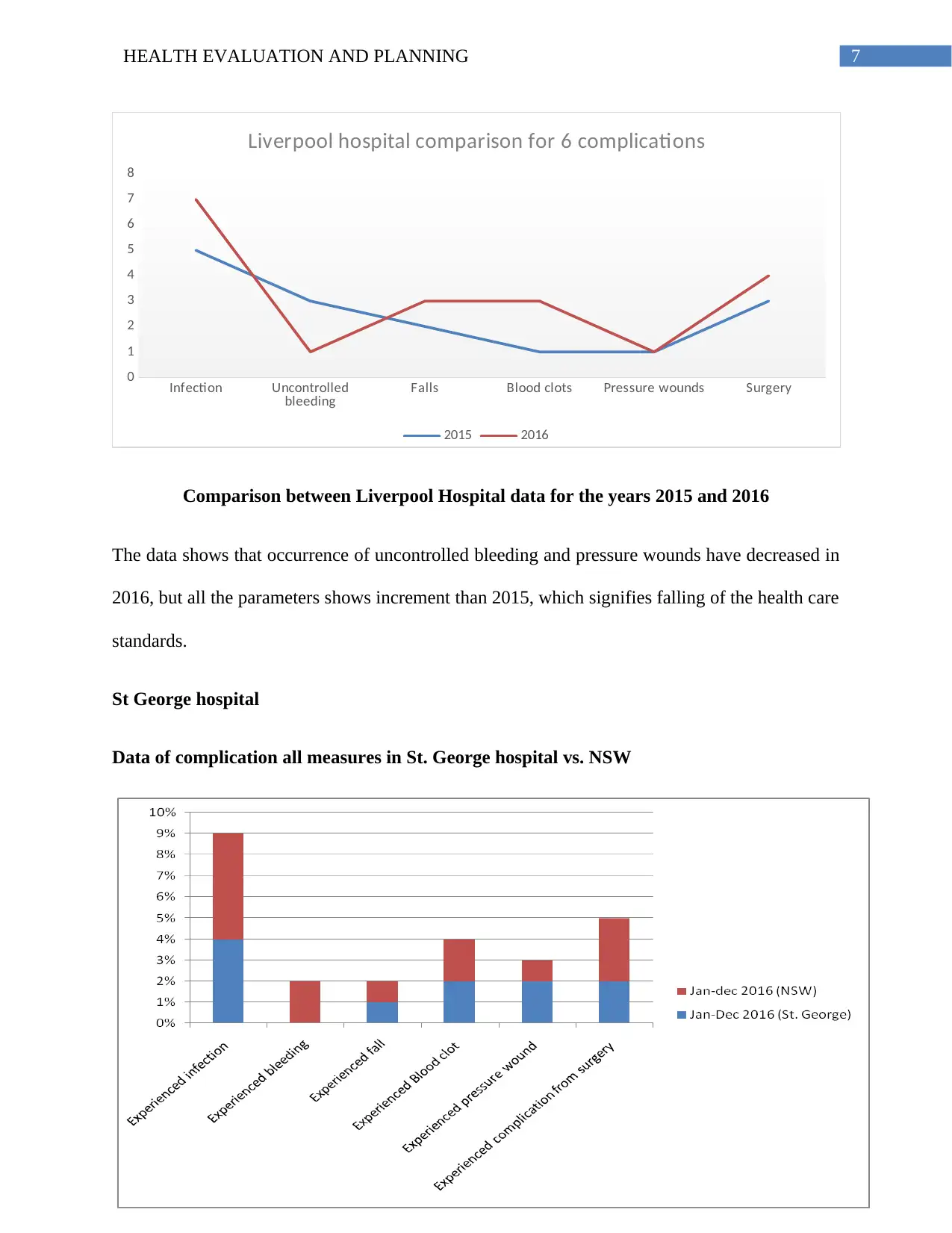
7HEALTH EVALUATION AND PLANNING
Infection Uncontrolled
bleeding Falls Blood clots Pressure wounds Surgery
0
1
2
3
4
5
6
7
8
Liverpool hospital comparison for 6 complications
2015 2016
Comparison between Liverpool Hospital data for the years 2015 and 2016
The data shows that occurrence of uncontrolled bleeding and pressure wounds have decreased in
2016, but all the parameters shows increment than 2015, which signifies falling of the health care
standards.
St George hospital
Data of complication all measures in St. George hospital vs. NSW
Infection Uncontrolled
bleeding Falls Blood clots Pressure wounds Surgery
0
1
2
3
4
5
6
7
8
Liverpool hospital comparison for 6 complications
2015 2016
Comparison between Liverpool Hospital data for the years 2015 and 2016
The data shows that occurrence of uncontrolled bleeding and pressure wounds have decreased in
2016, but all the parameters shows increment than 2015, which signifies falling of the health care
standards.
St George hospital
Data of complication all measures in St. George hospital vs. NSW
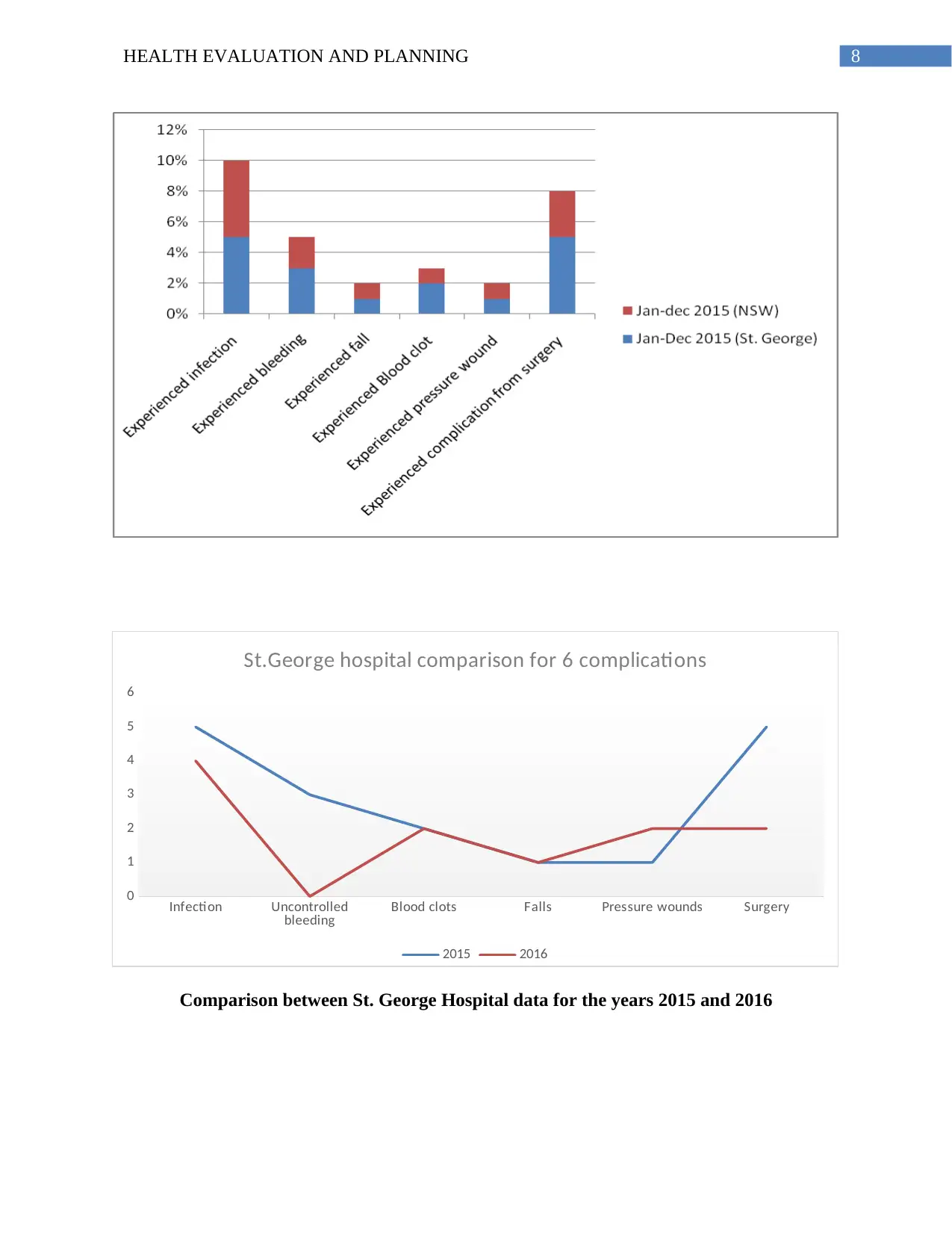
8HEALTH EVALUATION AND PLANNING
Infection Uncontrolled
bleeding Blood clots Falls Pressure wounds Surgery
0
1
2
3
4
5
6
St.George hospital comparison for 6 complications
2015 2016
Comparison between St. George Hospital data for the years 2015 and 2016
Infection Uncontrolled
bleeding Blood clots Falls Pressure wounds Surgery
0
1
2
3
4
5
6
St.George hospital comparison for 6 complications
2015 2016
Comparison between St. George Hospital data for the years 2015 and 2016
⊘ This is a preview!⊘
Do you want full access?
Subscribe today to unlock all pages.

Trusted by 1+ million students worldwide
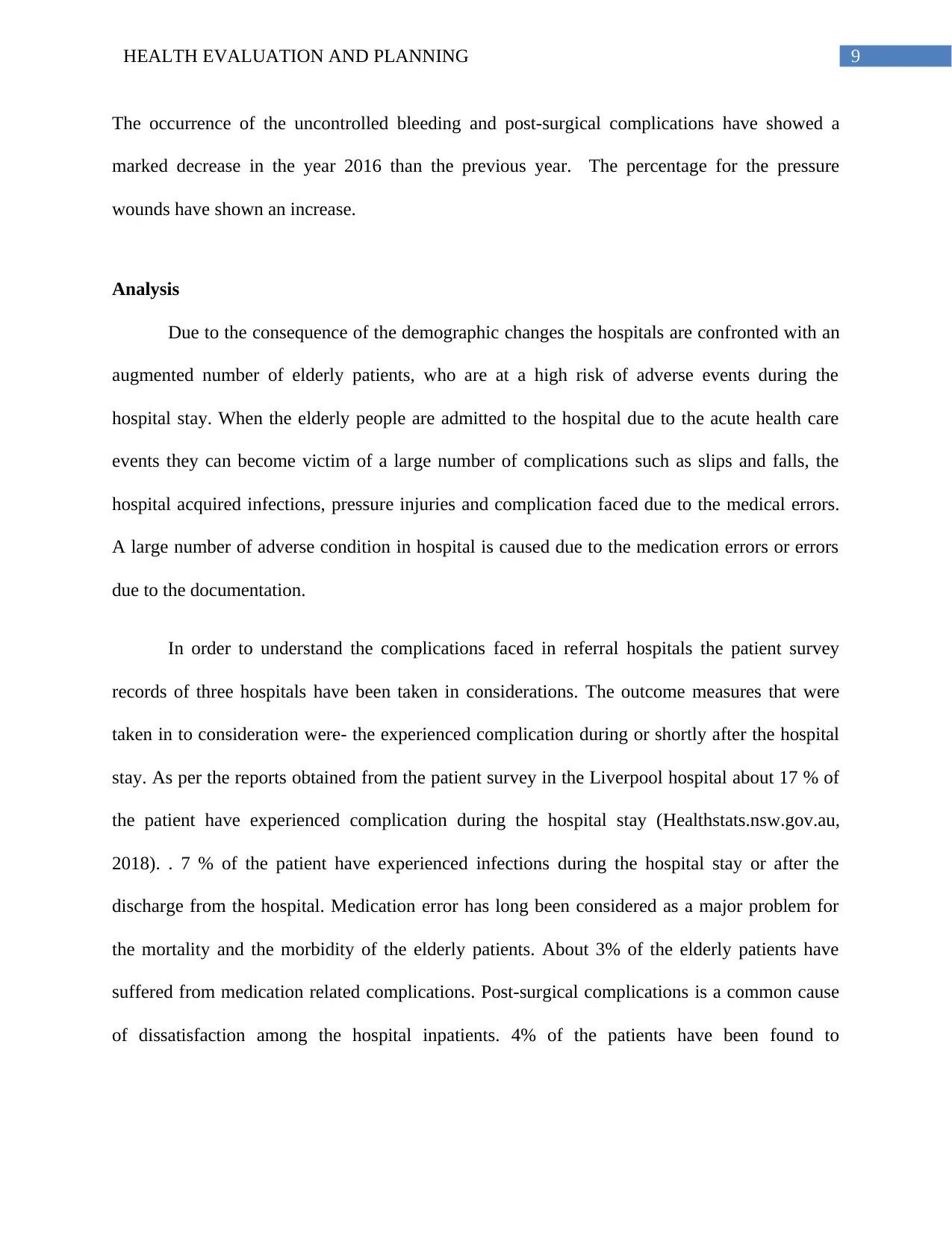
9HEALTH EVALUATION AND PLANNING
The occurrence of the uncontrolled bleeding and post-surgical complications have showed a
marked decrease in the year 2016 than the previous year. The percentage for the pressure
wounds have shown an increase.
Analysis
Due to the consequence of the demographic changes the hospitals are confronted with an
augmented number of elderly patients, who are at a high risk of adverse events during the
hospital stay. When the elderly people are admitted to the hospital due to the acute health care
events they can become victim of a large number of complications such as slips and falls, the
hospital acquired infections, pressure injuries and complication faced due to the medical errors.
A large number of adverse condition in hospital is caused due to the medication errors or errors
due to the documentation.
In order to understand the complications faced in referral hospitals the patient survey
records of three hospitals have been taken in considerations. The outcome measures that were
taken in to consideration were- the experienced complication during or shortly after the hospital
stay. As per the reports obtained from the patient survey in the Liverpool hospital about 17 % of
the patient have experienced complication during the hospital stay (Healthstats.nsw.gov.au,
2018). . 7 % of the patient have experienced infections during the hospital stay or after the
discharge from the hospital. Medication error has long been considered as a major problem for
the mortality and the morbidity of the elderly patients. About 3% of the elderly patients have
suffered from medication related complications. Post-surgical complications is a common cause
of dissatisfaction among the hospital inpatients. 4% of the patients have been found to
The occurrence of the uncontrolled bleeding and post-surgical complications have showed a
marked decrease in the year 2016 than the previous year. The percentage for the pressure
wounds have shown an increase.
Analysis
Due to the consequence of the demographic changes the hospitals are confronted with an
augmented number of elderly patients, who are at a high risk of adverse events during the
hospital stay. When the elderly people are admitted to the hospital due to the acute health care
events they can become victim of a large number of complications such as slips and falls, the
hospital acquired infections, pressure injuries and complication faced due to the medical errors.
A large number of adverse condition in hospital is caused due to the medication errors or errors
due to the documentation.
In order to understand the complications faced in referral hospitals the patient survey
records of three hospitals have been taken in considerations. The outcome measures that were
taken in to consideration were- the experienced complication during or shortly after the hospital
stay. As per the reports obtained from the patient survey in the Liverpool hospital about 17 % of
the patient have experienced complication during the hospital stay (Healthstats.nsw.gov.au,
2018). . 7 % of the patient have experienced infections during the hospital stay or after the
discharge from the hospital. Medication error has long been considered as a major problem for
the mortality and the morbidity of the elderly patients. About 3% of the elderly patients have
suffered from medication related complications. Post-surgical complications is a common cause
of dissatisfaction among the hospital inpatients. 4% of the patients have been found to
Paraphrase This Document
Need a fresh take? Get an instant paraphrase of this document with our AI Paraphraser
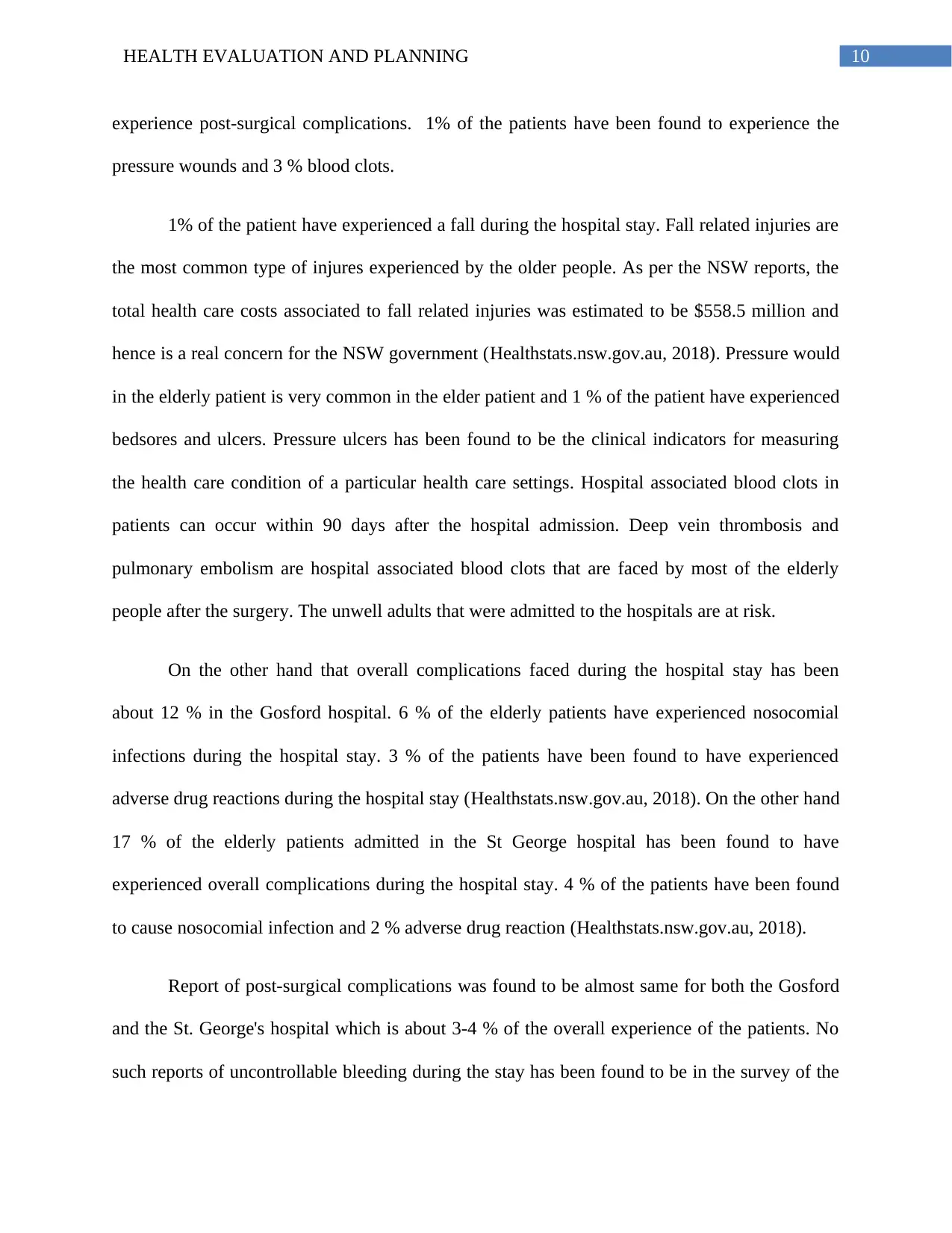
10HEALTH EVALUATION AND PLANNING
experience post-surgical complications. 1% of the patients have been found to experience the
pressure wounds and 3 % blood clots.
1% of the patient have experienced a fall during the hospital stay. Fall related injuries are
the most common type of injures experienced by the older people. As per the NSW reports, the
total health care costs associated to fall related injuries was estimated to be $558.5 million and
hence is a real concern for the NSW government (Healthstats.nsw.gov.au, 2018). Pressure would
in the elderly patient is very common in the elder patient and 1 % of the patient have experienced
bedsores and ulcers. Pressure ulcers has been found to be the clinical indicators for measuring
the health care condition of a particular health care settings. Hospital associated blood clots in
patients can occur within 90 days after the hospital admission. Deep vein thrombosis and
pulmonary embolism are hospital associated blood clots that are faced by most of the elderly
people after the surgery. The unwell adults that were admitted to the hospitals are at risk.
On the other hand that overall complications faced during the hospital stay has been
about 12 % in the Gosford hospital. 6 % of the elderly patients have experienced nosocomial
infections during the hospital stay. 3 % of the patients have been found to have experienced
adverse drug reactions during the hospital stay (Healthstats.nsw.gov.au, 2018). On the other hand
17 % of the elderly patients admitted in the St George hospital has been found to have
experienced overall complications during the hospital stay. 4 % of the patients have been found
to cause nosocomial infection and 2 % adverse drug reaction (Healthstats.nsw.gov.au, 2018).
Report of post-surgical complications was found to be almost same for both the Gosford
and the St. George's hospital which is about 3-4 % of the overall experience of the patients. No
such reports of uncontrollable bleeding during the stay has been found to be in the survey of the
experience post-surgical complications. 1% of the patients have been found to experience the
pressure wounds and 3 % blood clots.
1% of the patient have experienced a fall during the hospital stay. Fall related injuries are
the most common type of injures experienced by the older people. As per the NSW reports, the
total health care costs associated to fall related injuries was estimated to be $558.5 million and
hence is a real concern for the NSW government (Healthstats.nsw.gov.au, 2018). Pressure would
in the elderly patient is very common in the elder patient and 1 % of the patient have experienced
bedsores and ulcers. Pressure ulcers has been found to be the clinical indicators for measuring
the health care condition of a particular health care settings. Hospital associated blood clots in
patients can occur within 90 days after the hospital admission. Deep vein thrombosis and
pulmonary embolism are hospital associated blood clots that are faced by most of the elderly
people after the surgery. The unwell adults that were admitted to the hospitals are at risk.
On the other hand that overall complications faced during the hospital stay has been
about 12 % in the Gosford hospital. 6 % of the elderly patients have experienced nosocomial
infections during the hospital stay. 3 % of the patients have been found to have experienced
adverse drug reactions during the hospital stay (Healthstats.nsw.gov.au, 2018). On the other hand
17 % of the elderly patients admitted in the St George hospital has been found to have
experienced overall complications during the hospital stay. 4 % of the patients have been found
to cause nosocomial infection and 2 % adverse drug reaction (Healthstats.nsw.gov.au, 2018).
Report of post-surgical complications was found to be almost same for both the Gosford
and the St. George's hospital which is about 3-4 % of the overall experience of the patients. No
such reports of uncontrollable bleeding during the stay has been found to be in the survey of the
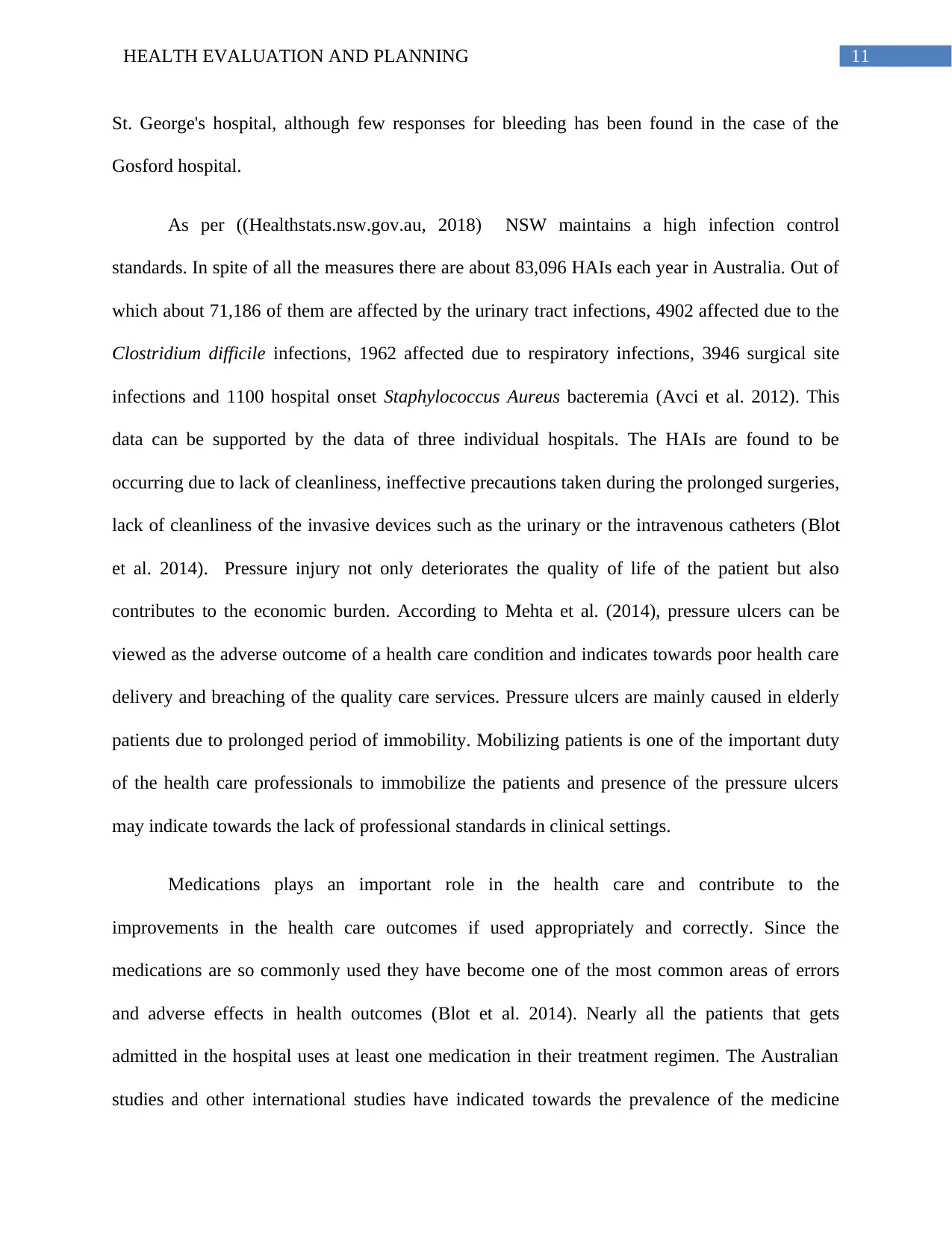
11HEALTH EVALUATION AND PLANNING
St. George's hospital, although few responses for bleeding has been found in the case of the
Gosford hospital.
As per ((Healthstats.nsw.gov.au, 2018) NSW maintains a high infection control
standards. In spite of all the measures there are about 83,096 HAIs each year in Australia. Out of
which about 71,186 of them are affected by the urinary tract infections, 4902 affected due to the
Clostridium difficile infections, 1962 affected due to respiratory infections, 3946 surgical site
infections and 1100 hospital onset Staphylococcus Aureus bacteremia (Avci et al. 2012). This
data can be supported by the data of three individual hospitals. The HAIs are found to be
occurring due to lack of cleanliness, ineffective precautions taken during the prolonged surgeries,
lack of cleanliness of the invasive devices such as the urinary or the intravenous catheters (Blot
et al. 2014). Pressure injury not only deteriorates the quality of life of the patient but also
contributes to the economic burden. According to Mehta et al. (2014), pressure ulcers can be
viewed as the adverse outcome of a health care condition and indicates towards poor health care
delivery and breaching of the quality care services. Pressure ulcers are mainly caused in elderly
patients due to prolonged period of immobility. Mobilizing patients is one of the important duty
of the health care professionals to immobilize the patients and presence of the pressure ulcers
may indicate towards the lack of professional standards in clinical settings.
Medications plays an important role in the health care and contribute to the
improvements in the health care outcomes if used appropriately and correctly. Since the
medications are so commonly used they have become one of the most common areas of errors
and adverse effects in health outcomes (Blot et al. 2014). Nearly all the patients that gets
admitted in the hospital uses at least one medication in their treatment regimen. The Australian
studies and other international studies have indicated towards the prevalence of the medicine
St. George's hospital, although few responses for bleeding has been found in the case of the
Gosford hospital.
As per ((Healthstats.nsw.gov.au, 2018) NSW maintains a high infection control
standards. In spite of all the measures there are about 83,096 HAIs each year in Australia. Out of
which about 71,186 of them are affected by the urinary tract infections, 4902 affected due to the
Clostridium difficile infections, 1962 affected due to respiratory infections, 3946 surgical site
infections and 1100 hospital onset Staphylococcus Aureus bacteremia (Avci et al. 2012). This
data can be supported by the data of three individual hospitals. The HAIs are found to be
occurring due to lack of cleanliness, ineffective precautions taken during the prolonged surgeries,
lack of cleanliness of the invasive devices such as the urinary or the intravenous catheters (Blot
et al. 2014). Pressure injury not only deteriorates the quality of life of the patient but also
contributes to the economic burden. According to Mehta et al. (2014), pressure ulcers can be
viewed as the adverse outcome of a health care condition and indicates towards poor health care
delivery and breaching of the quality care services. Pressure ulcers are mainly caused in elderly
patients due to prolonged period of immobility. Mobilizing patients is one of the important duty
of the health care professionals to immobilize the patients and presence of the pressure ulcers
may indicate towards the lack of professional standards in clinical settings.
Medications plays an important role in the health care and contribute to the
improvements in the health care outcomes if used appropriately and correctly. Since the
medications are so commonly used they have become one of the most common areas of errors
and adverse effects in health outcomes (Blot et al. 2014). Nearly all the patients that gets
admitted in the hospital uses at least one medication in their treatment regimen. The Australian
studies and other international studies have indicated towards the prevalence of the medicine
⊘ This is a preview!⊘
Do you want full access?
Subscribe today to unlock all pages.

Trusted by 1+ million students worldwide
1 out of 20
Your All-in-One AI-Powered Toolkit for Academic Success.
+13062052269
info@desklib.com
Available 24*7 on WhatsApp / Email
![[object Object]](/_next/static/media/star-bottom.7253800d.svg)
Unlock your academic potential
Copyright © 2020–2025 A2Z Services. All Rights Reserved. Developed and managed by ZUCOL.


